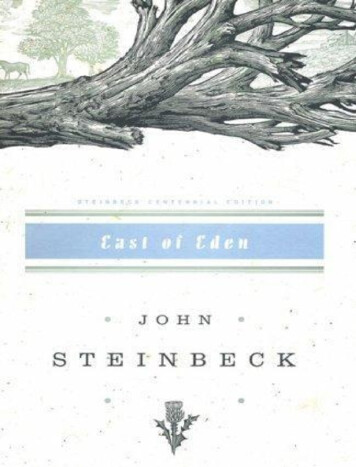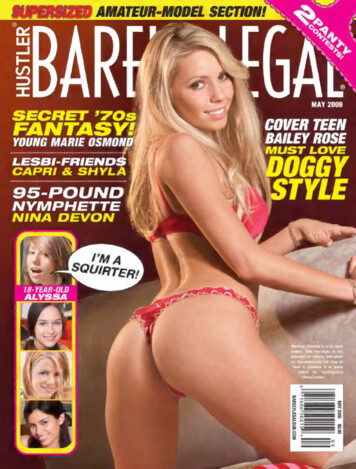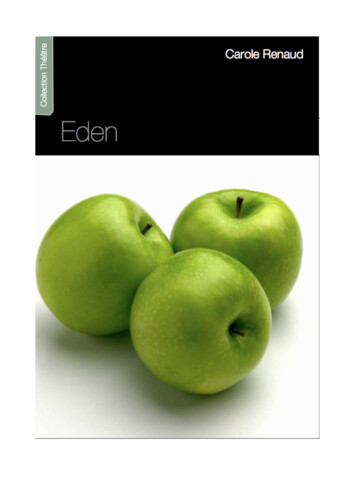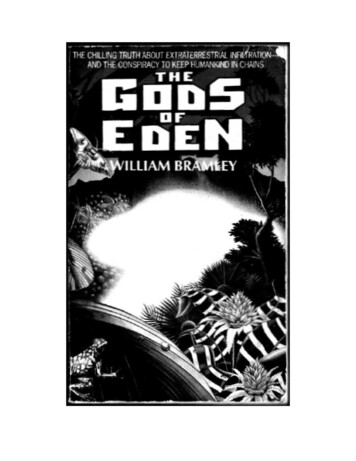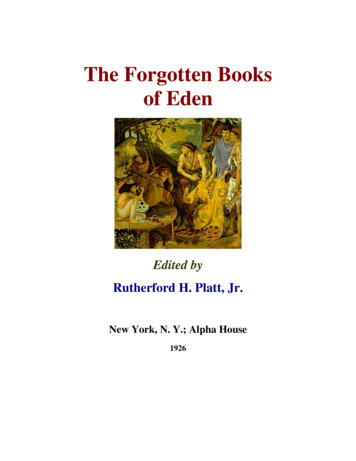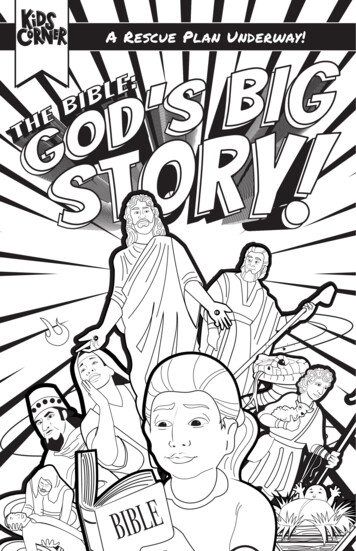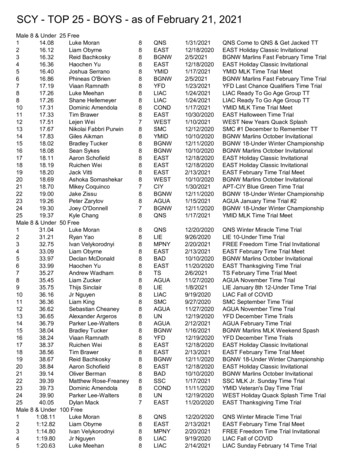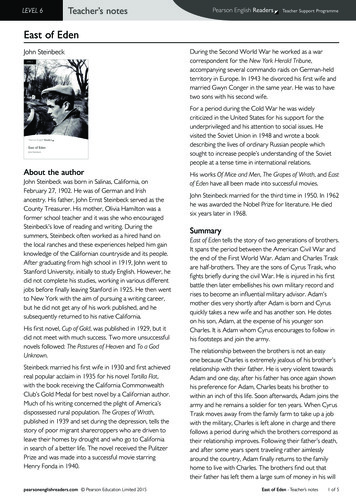
Transcription
level 6Teacher’s notesTeacher Support ProgrammeEast of EdenJohn SteinbeckDuring the Second World War he worked as a warcorrespondent for the New York Herald Tribune,accompanying several commando raids on German-heldterritory in Europe. In 1943 he divorced his first wife andmarried Gwyn Conger in the same year. He was to havetwo sons with his second wife.For a period during the Cold War he was widelycriticized in the United States for his support for theunderprivileged and his attention to social issues. Hevisited the Soviet Union in 1948 and wrote a bookdescribing the lives of ordinary Russian people whichsought to increase people’s understanding of the Sovietpeople at a tense time in international relations.About the authorJohn Steinbeck was born in Salinas, California, onFebruary 27, 1902. He was of German and Irishancestry. His father, John Ernst Steinbeck served as theCounty Treasurer. His mother, Olivia Hamilton was aformer school teacher and it was she who encouragedSteinbeck’s love of reading and writing. During thesummers, Steinbeck often worked as a hired hand onthe local ranches and these experiences helped him gainknowledge of the Californian countryside and its people.After graduating from high school in 1919, John went toStanford University, initially to study English. However, hedid not complete his studies, working in various differentjobs before finally leaving Stanford in 1925. He then wentto New York with the aim of pursuing a writing career,but he did not get any of his work published, and hesubsequently returned to his native California.His first novel, Cup of Gold, was published in 1929, but itdid not meet with much success. Two more unsuccessfulnovels followed: The Pastures of Heaven and To a GodUnknown.Steinbeck married his first wife in 1930 and first achievedreal popular acclaim in 1935 for his novel Tortilla Flat,with the book receiving the California CommonwealthClub’s Gold Medal for best novel by a Californian author.Much of his writing concerned the plight of America’sdispossessed rural population. The Grapes of Wrath,published in 1939 and set during the depression, tells thestory of poor migrant sharecroppers who are driven toleave their homes by drought and who go to Californiain search of a better life. The novel received the PulitzerPrize and was made into a successful movie starringHenry Fonda in 1940.pearsonenglishreaders.com Pearson Education Limited 2015His works Of Mice and Men, The Grapes of Wrath, and Eastof Eden have all been made into successful movies.John Steinbeck married for the third time in 1950. In 1962he was awarded the Nobel Prize for literature. He diedsix years later in 1968.SummaryEast of Eden tells the story of two generations of brothers.It spans the period between the American Civil War andthe end of the First World War. Adam and Charles Traskare half-brothers. They are the sons of Cyrus Trask, whofights briefly during the civil War. He is injured in his firstbattle then later embellishes his own military record andrises to become an influential military advisor. Adam’smother dies very shortly after Adam is born and Cyrusquickly takes a new wife and has another son. He doteson his son, Adam, at the expense of his younger sonCharles. It is Adam whom Cyrus encourages to follow inhis footsteps and join the army.The relationship between the brothers is not an easyone because Charles is extremely jealous of his brother’srelationship with their father. He is very violent towardsAdam and one day, after his father has once again shownhis preference for Adam, Charles beats his brother towithin an inch of this life. Soon afterwards, Adam joins thearmy and he remains a soldier for ten years. When CyrusTrask moves away from the family farm to take up a jobwith the military, Charles is left alone in charge and therefollows a period during which the brothers correspond astheir relationship improves. Following their father’s death,and after some years spent traveling rather aimlesslyaround the country, Adam finally returns to the familyhome to live with Charles. The brothers find out thattheir father has left them a large sum of money in his willEast of Eden - Teacher’s notes 1 of 5
level 6Teacher’s notesTeacher Support ProgrammeEast of Edenand they are intrigued as to how he managed to amasssuch a sum on his army pay.One day a badly beaten young woman appears on theTrasks’ doorstep. She is Cathy Ames, a beautiful but eviland manipulative prostitute, who has been left for deadby her pimp. The brothers give her shelter and take careof her. Adam soon falls in love with her and wants tomarry her. Charles is set against the marriage becausehe is aware of Cathy’s true character. His suspicionsare confirmed one night when she seduces him as hisbrother Adam lies sleeping. However, Adam and Cathyare married and she soon finds out that she is pregnant.Cathy doesn’t want the child and she tries to inducea miscarriage. The attempt goes badly wrong and shebecomes very ill.Adam decides to leave the family farm and start afreshwith his wife and new baby. He looks for some landon which he can build a house a make a new life. ButCathy tells him she doesn’t want this new life and thatshe will leave him when the child is born. Adam doesn’tbelieve her, but soon after she gives birth to twin boys,Cathy packs her things and gets ready to leave. WhenAdam tries to stop her, she coolly shoots him and leaveshim wounded. She leaves and returns to her life as aprostitute.For the first year of their lives, Adam is too unhappy anddepressed to give the boys names. Finally, he is persuadedby a neighbor that it is very important for him to do so,and they look to the biblical story of the Garden of Edenfor inspiration. The twins are named Caleb and Aaron.The twin brothers are raised by Adam and his Chineseservant, Lee. Aaron changes the spelling of his name toAron (page 54). The brothers are very different andwhile everybody seems to like Aron, people seem moreuneasy in the presence of Caleb. The father, just like inthe previous generation, also appears to favor Aron. Bothsons vie for their father’s affections, but Aron is moresuccessful in this. When Caleb attempts to buy his father’slove with a gift of money he has earned via a businessventure, he is rebuffed and unfavorably compared to hisbrother. Caleb is very jealous. He knows of their mother’swhereabouts and profession, while Aron believes herto be dead. As an act of vengeance against this father’sfavorite, Caleb takes Aron to the brothel run by theirmother. Aron is so grief-stricken that he enlists in theArmy and is killed while fighting in France. Things getworse when Adam Trask suffers a stroke upon hearingpearsonenglishreaders.com Pearson Education Limited 2015the news of this son’s death. Caleb is grief-stricken andblames himself for Aron’s death and Adam’s sickness.He worries that he is evil because his mother was evil.However, at the end of the book, Adam’s final words toCal seem to imply forgiveness—he reminds us, and hisson, that he has free will.Background and themesPublished in 1952, East of Eden is a story of good and evil.Steinbeck wrote it for his two young sons. He wanted toconvey to them the sights, sounds and smells of the SalinasValley. The novel is partly based on Steinbeck’s own lifegrowing up in the Salinas Valley. His mother’s name wasHamilton, the same name he chose to give to the Trask’sneighbors. He considered this to be his greatest novel. Hesaid about it: “It has everything in it I have been able tolearn about my craft or profession in all these years.”The novel is a symbolic recreation of the biblical story ofCain and Abel, told against a backdrop of the history ofthe Salinas Valley at the turn of the twentieth century.Among the many themes the book explores are thethemes of love, jealousy, guilt, acceptance, and freedom.Steinbeck brings themes together by making referencesto the Book of Genesis and especially the story of Cainand Abel. The link between the novel and the biblicalstory is made very apparent by the choice of the namesof both generations of brothers in the Trask family—thefirst letters of their names are a perfect match—firstCharles and Adam, and then Cal and Aron.But the parallels do not end there. In the biblical story,Cain works the land and Abel is a keeper of sheep. InEast of Eden, Charles is a farmer, and then Caleb investsin the bean harvest. In the Bible, Adam rejects Cain’s giftof crops and prefers Abel’s gift of a lamb, while in Eastof Eden, Cyrus rejects Charles’s gift of an expensive knifein favor of Adam’s gift of a stray puppy. This pattern isrepeated in the subsequent generation when Adam Traskrejects Caleb’s gift of money earned by investing in thebean crop and tells him he would rather he led a goodlife like his brother. In the Bible, Cain kills Abel after beingrejected by God, while in the novel Charles almost beatshis brother to death in a jealous rage after being rejectedby his father. In the second generation, Caleb’s jealousyindirectly kills his brother, Aron, when he makes him sodistraught over his mother that he enlists and goes to fightin the First World War.The mark that God put on Cain in order to deter othersfrom killing him in the biblical story is paralleled in bothEast of Eden - Teacher’s notes 2 of 5
level 6Teacher’s notesTeacher Support ProgrammeEast of Edengenerations of Trask brothers. In the first generation,Charles receives a dark scar on his forehead as the resultof an agricultural accident. In the second generation,people are frightened of Caleb’s appearance, which isdescribed as being darker and more sinister than that ofAron.In the Bible, Cain is the only brother who has offspring.In the novel, we learn that it is probably Charles, and nothis brother who is the real father of the twins. And in thesecond generation, Aron is killed before he has a chanceto produce any children and we are led to assume thatCal will go on to have children, possibly with the formersweetheart of his dead brother.In the story of Cain and Abel, Cain reaches the PromisedLand but Abel doesn’t. This suggests that there is hopefor Caleb even after he has brought about the death ofthis brother. He receives the love of a good woman andis given the chance to make a life for himself. He is notdoomed to follow in his mother’s footsteps; he is free todo good or evil.Possibly the main moral message of the story is thatwe have a free will, and we are always able to make achoice, even if that choice is a tough one. Several of thecharacters in the book have to face difficult choices.There is bad in all of us, but if we set our minds to it we“may rule sin.”3456Discussion activitiesBefore reading1Discuss: Put the students into small groups and havethem ask and answer the following questions:a Do you know the stories of Adam and Eve and Cainand Abel. Can you recount them to the otherstudents in your group?b Have you ever seen the movie “East of Eden”? Whowas the star of the movie whose picture is featuredon the front cover of the book? What do you knowabout his life?Chapters 1–3, pages 1–16After reading2Read carefully: Working in pairs, ask the students tore-read Chapter 1 and to note down two or threeimportant pieces of information that it gives aboutthe history of the Salinas Valley and the history of theHamilton family. Then, working individually, ask themto note down some similarly key points about theirown home town or region and/or their owngrandparents. Ask them to write down full sentences.Ask for students to volunteer to read out theirsentences. As a follow-up, you could ask them topearsonenglishreaders.com Pearson Education Limited 2015expand their sentences into a longer text, written inthe style of Chapter 1.Pair work: Divide the class into two equally-sizedgroups. Ask group A to imagine the feelings andthoughts of Cyrus and ask group B to imagine thefeelings and thoughts of Charles at the point in thestory on page 9 when Adam tells his father that hisson Charles thinks he doesn’t love him. Then put thestudents into pairs so that one person from group Aworks with one person in group B and have them actout a conversation between the two characters.Write: Split the class into two equally-sized groups, Aand B. Working individually, ask the students to writea letter. Students in group A write a letter fromCharles to Adam. Students in group B write a letterfrom Adam to Charles. Before they start writing,elicit from the class a few ideas concerning what eachof the brothers might want to say to the other inwriting that they could not say face-to-face. As afollow up, get students to exchange letters with astudent from the other group and to write a reply.Discuss: Working individually, asks students toconsider the following question: Why does Adam jointhe army? After a few minutes, put the students intosmall groups and ask them to come up with reasonswhy they think Adam re-enlists in the army for afurther five years. Then write up some of theirsuggestions on the board and turn the activity into awhole-class discussion.Role play: Ask the students to think about theconversation between Adam and his father when hisfather offers to have him posted to Washington sothey can work together. Ask them to imagine howeach of them feels. Then put students into pairs andask them to act out the conversation between them.Chapter 4, pages 16–28Before reading7Discuss: At the beginning of Chapter 4, we are toldthat Cathy Ames “was born without kindness or aconscience.” Put the students into pairs and ask themto consider the following question: Can the way aperson will grow up be determined from birth or is theenvironment responsible for a person’s behavior?After reading89Read carefully: Still working in pairs, ask the studentsto re-read the chapter and note down the ways inwhich Cathy Ames is presented as being evil. Thenask them to discuss the following question:Do you agree that Cathy Ames is “an evil beauty”?Role play: Divide the class into three equally-sizedgroups. Allocate one of the following characters toeach of the groups: Cathy Ames, Adam Trask, andCharles Trask. Ask each of the groups to re-tell theevents of Chapter 4 from the point of view of theircharacter. Ask one student per group to present theaccount orally in front of the whole class.East of Eden - Teacher’s notes 3 of 5
level 6Teacher’s notesTeacher Support ProgrammeEast of Eden10 Guess: Working in small groups, ask the students toimagine what is going to happen next in the story.You might like them to consider the followingquestions: Will Adam and Cathy go to California? WillAdam find out that his wife and his brother have slepttogether? What will happen if he does?Chapters 5–6, pages 28–4711 Read carefully: They say that love is blind. Ask thestudents to re-read Chapter 5 to find examples ofhow Adam Trask is blinded by his love for Cathy.After five or ten minutes, conduct a feedback sessionand write students’ suggestions on the board.12 Discuss: Following on from exercise 12, put studentsinto pairs and ask them to discuss the followingquestion: Do you have much sympathy for Adam, or doyou think that he brings many of his problems uponhimself?13 Role play: Put students in pairs and have them actout the dialogue between Adam Trask and HoraceQuinn on pages 38–39. Ask two or three of the pairsto act out the dialogue in front of the whole class.14 Debate: Is honesty always the best policy? Divide theclass into two equally-sized groups. Tell them thatthey are going to have a debate on the abovequestion. Write the following statement on theboard: This house believes that honesty is always thebest policy. Regardless of their personal views, allocateto one half of the class the role of arguing in favor ofthe statement, and to the other half, allocate the roleof arguing against the statement. Give the groupsenough time to prepare their arguments and to electtwo spokespersons. Then proceed with the debate,with the two speakers in favor going first. At the endof the debate have the class vote on the question.15 Discuss: Put the students into small groups. Havethem answer the following question: Does Kate feelany real affection for Faye? Back up your answers withevidence from Chapter 6. After ten or fifteen minutes,conduct a feedback session with the whole class.Chapters 7–9, pages 47–62After reading16 Role play: Put the students into pairs. Ask each pairto prepare to play the role of either Lee or SamuelHamilton. Tell them they are to role play aconversation between the two men in which theydecide what needs to be done about Adam and thetwins.17 Discuss: Put the students into small groups. Ask themto discuss the following question: Is Samuel Hamiltonjustified in hitting Adam Trask, or was there a morepeaceful way of making him see sense?18 Role play: Put the students into groups of four andhave them think about the following question: Whatare the problems faced by people when their parentsbecome elderly and can no longer look afterpearsonenglishreaders.com Pearson Education Limited 2015themselves? Write some of their ideas on the board.Then allocate the role of one of the Hamiltonchildren to each of the students and have them actout a conversation during which they decide whatneeds to be done with their father, Samuel.19 Discuss: At the end of Chapter 9, Samuel finallyreveals the truth about Adam’s wife working in awhorehouse. Put the students into small groups andask them to discuss the following questions: WasSamuel right to reveal the truth to Adam? If so, whydidn’t he do so earlier? After ten or fifteen minutes,broaden the discussion out into a whole-class activity.20 Guess: Samuel Hamilton says that by telling AdamTrask the truth about his wife he has forced him thechose to live or die. Put the students into pairs andhave them imagine what Adam is going to do nowthat he knows the truth. Ask several pairs to tell therest of the class what they think will happen andwrite up their ideas on the board.21 Role play: Ask the students to think about howAdam Trask must feel after seeing Cathy/Kate afterso many years. Does he still love her? Does he hate her?Ask them to consider how Lee, Adam’s faithfulservant feels about Adam. Then put them into pairsand tell them to write a dialogue between Adam andLee on Adam’s return from seeing his wife again. Getthem to act out their dialogues in front of the class.Chapters 10–12, pages 62–78After reading22 Role play: Tell the students to re-read Chapter 10,paying particular attention to the description of thecharacters of Aron and Cal, and of the relationshipbetween them. Working in pairs, ask the students toimagine a conversation between Aron and Cal thattakes place after they have gone to bed on page 67,and during which they discuss the day’s events—theirfight, their meeting with the Bacons, their potentialmove to Salinas, and the fact their father told themtheir mother was buried on the other side of thecountry.23 Discuss: Put the students into small groups and havethem discuss the following question: Should Adam tellhis sons the truth about their mother? Do you agree withLee that the greatest danger is that when they do findout that he lied about her they will never believe anythinghe has ever said or done? After ten or fifteen minutes,get the different groups to share their ideas with thewhole class.24 Write: As a whole-class activity, ask the students tothink of reasons why Adam wants to contact hisbrother Charles again. Put their suggestions on theboard. Then put the students into pairs and haveeach pair draft the letter that Adam writes to hisbrother Charles at the end of Chapter 10. Whenthey have finished, ask some of the pairs to read theirletter out loud to the rest of the class.East of Eden - Teacher’s notes 4 of 5
level 6Teacher’s notesTeacher Support ProgrammeEast of Eden25 Role play: Put the students into groups of four. Askthem to imagine that they are a group of friends ofAdam Trask and that he has come to them for adviceabout what to do about the news of his brother’s will.He doesn’t know whether to tell his wife about theinheritance or not. Regardless of their actual opinions,allocate roles to the students so that two of them arein favor of telling her and two of them are against.26 Debate: Put the students into pairs and ask them toconsider their answers to the following question: Doyou agree with the assertion on page 72 that “a manwill have only one question left at the end of his life: wasit good or evil?” After ten minutes or so, ask one ofthe pairs to volunteer their opinions and invite therest of the group to react to it. Continue for as longas the group remains interested in the topic.27 Role play: Ask the students to work in pairs. Tellthem they are businessmen who have to choosebetween the two opportunities that are describedin Chapter 12 — either they can invest in therefrigeration project and hope to sell frozenvegetables to the people in the East, or they caninvest in beans to sell to people in war-torn Europe.Regardless of their personal opinions, allocate rolesso that half of the pairs are in favor of therefrigeration venture, and the other pairs are in favorof the bean venture. Give them ten to fifteenminutes to prepare their case. Tell them to bear inmind the risks involved in each venture and toremember that in 1915, refrigeration was a relativelynew technology. After the preparation period, creategroups of four by bringing the pairs together two pairtogether, and have them role play a meeting at whichthey reach a decision.28 Research: On page 75, Will tells Adam: “People inthe East aren’t used to vegetables in the winter. Theywouldn’t buy them.” Ask the students to do someresearch into how the market for importedvegetables has developed over the years. How manytraditionally out-of-season vegetables are currentlyavailable in the shops? How has this changed over thepast few decades?29 Pair work: Ask the students to work in pairs. Theyshould imagine that they can interview Lee or CathyAmes. Ask them to decide on ten questions that theywould ask and how each of the characters mightanswer. Then ask the pairs to act out their interviewin front of the rest of the class.Chapters 13–15, pages 79–97After reading31 Role play: Put the students into pairs and get eachpair to prepare a short monologue by one of thecharacters in the book. Give them plenty of timeto practice the monologue and then ask them toperform it in front of the whole class. The rest of theclass has to guess which character they are playing.32 Pair work: Working in pairs, ask the students to thinkof reasons why each of the brothers decides not totell their father of their activities in Chapter 13.33 Debate: Making money from war. Divide the classinto two equal halves. Then divide each half intosmaller groups to make sure everybody canparticipate in the activity. Tell one half of the class tothink of all the arguments they can to justify makingmoney from war (the way Cal does). Tell the otherhalf to think of as many arguments as they can tocondemn making money from war (the way Adamdoes). After ten minutes or so, conduct a whole-classdebate on the issue. Alternatively, have different pairsof students act out an argument between Adam andCal.34 Research: Tell the students to do some research intothe First World War. This can be very basic stuff,such as: When did the War start and finish? How manycountries were involved? Where did the fighting takeplace? How many casualties were suffered by thedifferent countries involved, etc.?35 Pair work: Put the students into pairs and ask thento imagine the conversation between Cal and Aronwhen Cal shows his brother where his mother is onpage 88. Get them to practice it and then call onvolunteers to perform their dialogue in front of thewhole class.36 Write: Tell the students to imagine how Aron Traskfeels when he finds out the truth about his mother.Use the board to note down the students’suggestions. After a few minutes, tell the students toimagine they are Aron and to write a letter to theirfather explaining their reasons for joining the army.37 Write: Tell the students to imagine how Kate feelswhen she sees Aron with Cal in the scene on page88. Use the board to note down the students’suggestions. After a few minutes, tell the students toimagine they are Kate and to write a letter to Adamexplaining her reasons for ending her own life.38 Discuss: Put the students in small groups and askthem to consider the following questions: Who is yourfavorite character in the book and why? Who is yourleast favorite character in the book and why?30 Discuss: Put the students into small groups. Writethe names of the two brothers on the board—Caland Aron. Ask the groups to decide which of thebrothers they have more sympathy for and why. Givethe groups ten or fifteen minutes to discuss the topicbefore broadening the activity out into a whole-classactivity.pearsonenglishreaders.com Pearson Education Limited 2015East of Eden - Teacher’s notes 5 of 5
East of Eden, Charles is a farmer, and then Caleb invests in the bean harvest. In the Bible, Adam rejects Cain’s gift of crops and prefers Abel’s gift of a lamb, while in East of Eden, Cyrus rejects Charles’s gift of an expensive knife

